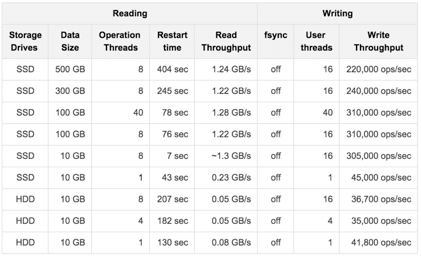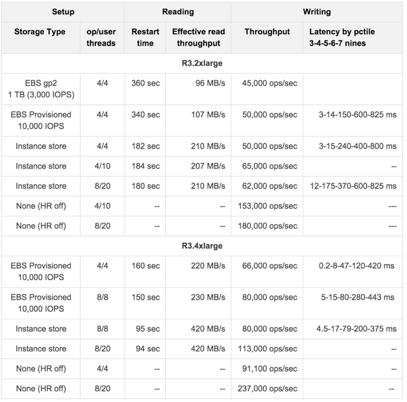Find summaries of Persistence performance tests that were performed with a single Hazelcast member running on a physical server and on AWS R3.
Performance on a Physical Server
We have tested a member which has a map with High-Density Data Store. Its data size is changed for each test, started from 10 GB to 500 GB (each map entry has a value of 1 KB).
The tests investigate the write and read performance of Persistence and are performed on HP ProLiant servers with RHEL 7 operating system using Hazelcast Simulator.
The following are the specifications of the server hardware used for the test:
-
CPU: 2x Intel® Xeon® CPU E5-2687W v3 @ 3.10GHz – with 10 cores per processor. Total 20 cores, 40 with hyper threading enabled.
-
Memory: 768GB 2133 MHz memory 24x HP 32GB 4Rx4 PC4-2133P-L Kit
The following are the storage media used for the test:
-
A hot-pluggable 2.5 inch HDD with 1 TB capacity and 10K RPM.
-
An SSD, Light Endurance PCle Workload Accelerator.
The below table shows the test results.

Performance on AWS R3
We have tested a member which has an IMap with High-Density Data Store:
-
This map has 40 million distinct keys, each map entry is 1 KB.
-
High-Density Memory Store is 59 GiB whose 19% is metadata.
-
Persistence is configured with
fsyncturned off. -
Data size reloaded on restart is 38 GB.
The tests investigate the write and read performance of Persistence and are performed on R3.2xlarge and R3.4xlarge EC2 instances using Hazelcast Simulator.
The following are the AWS storage types used for the test:
-
Elastic Block Storage (EBS) General Purpose SSD (GP2)
-
Elastic Block Storage with Provisioned IOPS (IO1) (Provisioned 10,000 IOPS on a 340 GiB volume, enabled EBS-optimized on instance)
-
SSD-backed instance store
The below table shows the test results.

